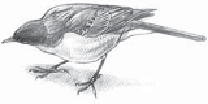Biology Reference
In-Depth Information
Q When robins cock their heads toward the ground, are they listening for
worms?
A
Nope, they're looking for them. A scientist named Frank Heppner designed an elegant
series of experiments to establish that vibrations, odors, and sounds do not help robins
find worms. Instead, robins see worms inside their subterranean burrows by peeking into
the tiny holes at the surface, or they watch for them wiggling on the ground. Robins cock
their heads to focus close up with one eye. The pupil of the eye looking up is adjusted for
daylight while the one focused down is open wider for seeing inside the dark little holes.
Male robins sing most intensely while it's still too dark to see worms, and females lay
theireggsatmidmorningratherthanatdawnwhenmostsongbirdsdo.Thisenablesthem
to focus their attention entirely on feeding during the time of day when worms are most
visible, at first light before the sun sends them underground for the day.
TheotherbirdmostspecializedforfeedingonearthwormsistheAmericanWoodcock,
a plump shorebird with a very long bill. Like robins, woodcocks pick up any earthworms
they might see wriggling about on the surface. Woodcocks probably detect underground
wormsatleastpartlybytouch,probingbeneaththesoilwiththesensitivetipoftheirlong
bill.
Hear and There
Q Why are owls the only birds with visible ears?
A
All birds have ears, usually hidden behind feathers on the sides of their face. The “ear
tufts” on owls aren't ears at all, but feathers sticking up on their heads. Ornithologists
speculate that when the feather tufts are raised, typically when an owl is alarmed, they
make the bird look somewhat like a broken branch, which may help the owl avoid detec-
tion.
Thefeathertuftsmayalsohelpowlsrecognizeandvisuallycommunicatewithonean-
other.Afewpeoplethinkthefeathersmayenhancetheirsenseoftoucharoundtheirface,
since every feather is attached to a nerve. These ear tufts also enhance many yellow-eyed
owls' catlike appearance, and so may give them a second or two of extra time to escape
when approached by a predator, because even large predators are at least a little intimid-
ated by the claws, teeth, and fierce fighting ability of cats.







